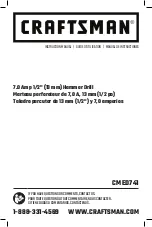
14
GB
ORIGINAL INSTRUCTIONS
Insert an appropriate drill bitt to the area des-
ignated for the opening.
Gradually press the trigger of the tool.
To make it easier to take the drill bit out of the
hole, release the pressure on the switch, wait
for the drill bit to come to a complete stop.
Change the direction of rotation to opposite
and tap the trigger gently. Take the drill bit out
of the hole carefully.
After fi nished work, dismantle the pneumatic
system and preserve the tool.
MAINTENANCE
Never use gasoline, solvent or other fl amma-
ble liquid to clean the tool. The vapours can
be ignited, may result the tool explosion and
serious injury.
Solvents, used to clean the tool holder and the
body, can result softening of seals. Thorough-
ly dry out the tool before starting your work.
In case of any irregularities in the tool opera-
tion, the tool should be immediately discon-
nected from the pneumatic system. All the
components of the pneumatic system must
be protected against contamination. Any
contamination which enters the pneumatic
system can damage the tool and other com-
ponents of the pneumatic system.
Tool maintenance before each use.
Disconnect the tool from the pneumatic system.
Before each use, let a few drops of preserva-
tive fl uid WD-40 through the air inlet.
Connect the tool to the pneumatic system
and run for about 30 seconds. It will allow to
distribute the preservative fl uid inside the tool
and clean it.
Disconnect the tool from the pneumatic sys-
tem again.
Let a few drops of oil with viscosity SAE 10
inside the tool, through the air inlet and spe-
cial designed openings for this purpose. It’s
recommended to use oil SAE 10 intended for
maintenance of pneumatic tools. Connect
the tool and run it for the short time.
Note! WD-40 may not be used as an appro-
priate lubricating oil.
Wipe away excess oil, which has leaked out
through the outlets. The oil, which has been
leave may damage the tool seals.
Other maintenance operations
Before each use of the tool, check that no signs
of damage are visible on the tool. Tool drivers,
holders and the spindles must be kept clean.
Every 6 months or after 100 hours of opera-
tion, it’s necessary to hand over the tool for
reviewing by the qualifi ed personnel in the
repair workshop. If the tool was used without
the use of a recommended air supply sys-
tem, it’s necessary to increase the frequency
for reviewing of the tool.
Troubleshooting
It’s necessary to stop using the tool immedi-
ately, if the tool is found to be defective. Us-
ing a defective tool can cause injury. All re-
pairs or replacements of the tool components
should be carried out by qualifi ed personnel
at an authorized repair workshop.
Defect
Possible solutions
Tool is
running
too
slowly
or does
not
start.
Let a few drops of preservative fl uid WD-40
through the air inlet. Run the tool for about
few seconds. The blades may stick to the
rotor. Run the tool for about 30 seconds.
Lubricate the tool with small amount of
oil. Note! The excess of oil can cause a
decrease in power of tool. In this case, it’s
necessary to clean the drive.
The tool
starts
and
then
releas-
es.
The compressor does not provide the correct
air supply. The tool operates by the air
collected in the compressor tank. As the tank
gets emptier, the compressor has not kept
pace with the refi lling of air shortages. Con-
nect the tool to a more effi cient compressor.
Insuf-
fi cient
power
Ensure that the hoses have an internal
diameter of at least such as specifi ed in the
table in point 3. Check the set point of pres-
sure, whether it’s set to the maximum value.
Ensure that the tool is properly cleaned and
lubricated. In case a lack of results, forward
the tool for repair.
Spare parts
In order to obtain the information on spare
parts for pneumatic tools, it’s necessary to
contact the manufacturer or its representative.
After fi nishing work, the casing, ventilation
slots, switches, additional holder and covers
should be cleaned, for example, with a stream
of air (at a pressure not exceeding 0.3 MPa),
with a brush or a dry cloth without the use of
chemicals and cleaning liquids. Clean tools
and holders with a dry, clean cloth.
Used tools are secondary raw materials - do
not dispose of it in household waste contain-
ers because it contains hazardous substanc-
es to human health or the environment! We
ask for active help in the economical man-
agement of natural resources and protection
of the natural environment by forwarding the
worn tools to the point of storage of worn
equipment. To reduce the amount of dis-
posed waste it’s necessary to re-use them,
recycle or recover in another form.
Содержание VOREL 81122
Страница 88: ...INSTRUKCJA ORYGINALNA 88 ...















































